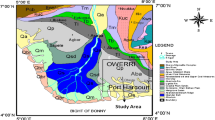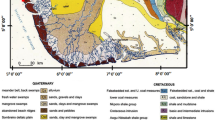Abstract
Thin hydrocarbon reservoir facies pose resolution challenges and waveform-signature opportunities in seismic reservoir characterization and prospect identification. In this study, we present a case study, where instantaneous frequency variation in response to a thin hydrocarbon pay zone is analyzed and integrated with other independent information to explain drilling results and optimize future drilling decisions. In Morrison NE Field, some wells with poor economics have resulted from well-placement incognizant of reservoir heterogeneities. The study area in Clark County, Kanas, USA, has been covered by a surface 3D seismic reflection survey in 2010. The target horizon is the Viola limestone, which continues to produce from 7 of the 12 wells drilled within the survey area. Seismic attributes extraction and analyses were conducted with emphasis on instantaneous attributes and amplitude anomalies to better understand and predict reservoir heterogeneities and their control on hydrocarbon entrapment settings. We have identified a higher instantaneous frequency, lower amplitude seismic facies that is in good agreement with distinct lithofacies that exhibit better (higher porosity) reservoir properties, as inferred from well-log analysis and petrographic inspection of well cuttings. This study presents a pre-drilling, data-driven approach of identifying sub-resolution reservoir seismic facies in a carbonate formation. This workflow will assist in placing new development wells in other locations within the area. Our low amplitude high instantaneous frequency seismic reservoir facies have been corroborated by findings based on well logs, petrographic analysis data, and drilling results.

(Modified after Richardson 2013)

(Adjusted from http://www.kshs.org, 2015)

(http://www.kgs.ku.edu/PRS/County/abc/clark.html: accessed, September 2016)

(Modified after Cole 1975)












Similar content being viewed by others
References
Adkinson, W. L. (1972). Stratigraphy and structure of middle and upper ordovician rocks in the sedgwick basin and adjacent areas, South-Central Kansas. Geological Survey Professional Paper 702.
Bornemann, E., Doveton, J. H., & St. Clair, P. N. (1982). Lithofacies analysis of the Viola Limestone in South-central Kansas: Kansas Geol. Survey. Petrophysical Series, 3, 50.
Brown, A. R. (2011). Interpretation of three-dimensional seismic data. AAPG Memoir 42, SEG Investigations in Geophysics (pp. 286–287).
Bunt, R. J. W. (2015). The use of seismic attributes for fan and reservoir definition in the Sea Lion Field. North Falkland Basin. Petroleum Geoscience, 21(2–3), 137–149.
Castagna, J. P., Siegfried, R. W., & Sun, S. (2003). Instantaneous spectral analysis: detection of low frequency shadows associated with hydrocarbons. The Leading Edge, 22, 120–127.
Chen, Q., & Sidney, S. (1997). Seismic attribute technology for reservoir forecasting and monitoring. The Leading Edge, 16(5), 445–448.
Chopra, S., & Marfurt, K. J. (2007). Seismic attributes for prospect identification and reservoir characterization. SEG Geophysical Development Series No. 11. Tulsa: Society of Exploration Geophysicists.
Chopra, S., & Marfurt, K. J. (2008). Emerging and future trends in seismic attributes. The Leading Edge, 27(3), 298–318.
Cole, V.B. (1975). Subsurface Ordovician-Cambrian rocks in Kansas with maps showing the thickness of potentially oil-bearing formations. Subsurface Geology Series 2 (p. 18). Lawrence, USA: Kansas Geological Survey.
Coléou, T., Poupon, M., & Azbel, K. (2003). Unsupervised seismic facies classification: a review and comparison of techniques and implementation. The Leading Edge, 22(10), 942–953.
Elsayed, R. E. (2001). Seismic modeling and multi attribute analysis—Guiding applications of 3D seismic attributes to reservoir characterization. University of Science and Technology, PhD-Thesis, Cracow, Poland, pp. 20–26.
Elsayed, R. A., & Ślusarczyk, R. (2000). Analysis of seismic attributes responses to a thinning layer. Romanian Geophysics, 7(Suppl. 1).
Goebel, E. D. (1968). Mississippian rocks of western Kansas. American Association of Petroleum Geologists Bulletin 52, 1732–1778.
Hardage, B. A. (2009). Frequencies are fault finding factors: looking low aids data interpretation. AAPG Explorer, 30(9), 34.
http://www.kgs.ku.edu/PRS/County/abc/clark.html. Accessed Sept 2016.
IHS Global Inc. (2012). Rock solid attributes, Version 8.7.
Kallweit, R. S., & Wood, L. C. (1982). The limits of resolution of zero-phase wavelets. Geophysics, 47, 1035–1046.
Raef, A. E., Mattern, F., Philip, C., & Totten, M. W. (2015). 3D seismic attributes and well-log facies analysis for prospect identification and evaluation: interpreted palaeoshoreline implications, Weirman Field, Kansas, USA. Journal of Petroleum Science and Engineering, 133, 40–51.
Raef, A. E., Meek, T. N., & Totten, M. W. (2016). Applications of 3D seismic attribute analysis in hydrocarbon prospect identification and evaluation: verification and validation based on fluvial palaeochannel cross-sectional geometry and sinuosity, Ness County, Kansas, USA. Marine and Petroleum Geology, 73, 21–35.
Richardson, L. J. (2013). The Herd Viola trend, Comanche County, Kansas. AAPG Search and Discovery Article #20220.
Sheriff, R. E., & Geldart, L. P. (1995). Exploration seismology. Cambridge: Cambridge University Press.
St. Clair, P. N. (1981). Depositional history and diagenesis of the Viola Limestone in south-central Kansas: Unpub. M.S. thesis, University of Kansas, p. 66.
Taner, M. T. (2001). Seismic attributes, rock solid images, Houston, TX, USA. CSEG Recorder, September, 2001, pp. 48–56.
Taner, M. T., Koehler, F., & Sheriff, R. E. (1979). Complex seismic trace analysis. Geophysics, 44(6), 1041–1063.
Wang, Z., Gao, J., Lei, X., Cui, X., & Wang, D. (2016). Application of 3D seismic attributes to optimize the placement of horizontal wells within a tight gas sand reservoir, Ordos Basin, China. Geophysics, 81(3), B77–B86.
Widess, M. B. (1973). How thin is a thin bed? Geophysics, 38, 1176–1180.
Zeng, H. (2010). Geologic significance of anomalous instantaneous frequency. Geophysics, 75(3), P23–P30.
Acknowledgements
The authors wish to thank Dan Reynolds of Coral Coast Petroleum of Wichita, Kansas, USA, for his assistance in providing data and expertise to the project.
Author information
Authors and Affiliations
Corresponding author
Rights and permissions
About this article
Cite this article
Raef, A., Totten, M., Vohs, A. et al. 3D Seismic Reflection Amplitude and Instantaneous Frequency Attributes in Mapping Thin Hydrocarbon Reservoir Lithofacies: Morrison NE Field and Morrison Field, Clark County, KS. Pure Appl. Geophys. 174, 4379–4394 (2017). https://doi.org/10.1007/s00024-017-1664-1
Received:
Revised:
Accepted:
Published:
Issue Date:
DOI: https://doi.org/10.1007/s00024-017-1664-1




